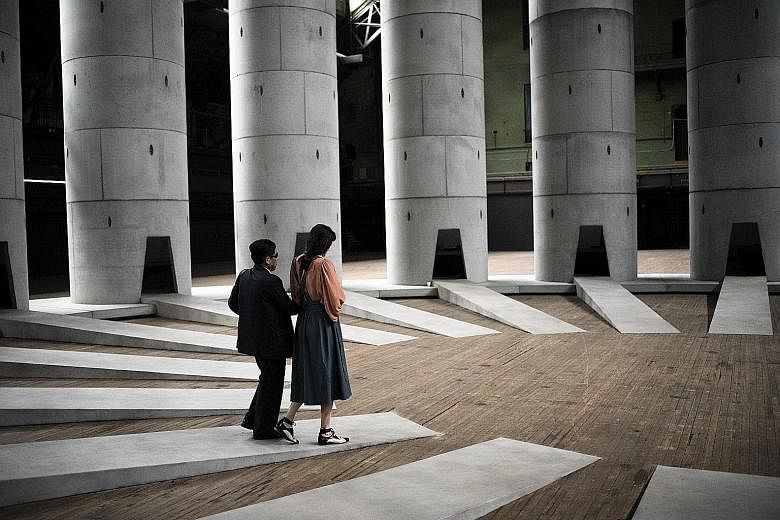NEW YORK • The artist Taryn Simon has brought 30 professional mourners to Manhattan from Burkina Faso, Cambodia, Russia, Venezuela and other parts of the globe as the centrepiece of her multi-disciplinary artwork, An Occupation Of Loss.
It explores responses to grief, touching on the empty spaces, private and public, that loss produces, and the chaos, ritual and ceremony that help people fill the void.
Traditionally, professional mourners are hired by the families of the deceased to mark the occasion and to guide the dead to where they will lead their afterlife. Mourners are called upon to mark larger losses within their communities, such as displacement or exile, in a cultural role that is part witness, part historian and part poet.
At Park Avenue Armory, where the artwork is being staged till Sept 25, their laments, wails and cries are also testament to their own bereavements. They can be a political testimony too.
Armenia's Mr Aziz Tamoyan, conducting a sound check with Simon last week, gave voice for the first time in the 5,110 sq m Drill Hall.
His "kilame ser" (words about) addressed the 2014 Sinjar massacre, when 50,000 Yazidis, ethnic Kurds, fled to the mountains to escape the Islamic State (Isis) in Iraq and Syria.
His strong-throated lament, underscored by an oboe and an amplifier which produced a droning baseline, rose up into the 24m vault of the Armory like fire turning softly to smoke - an incineration of the heart's earthly bonds.
Mr Tamoyan is president of the Yazidi National Union, which works to preserve the group's cultural heritage.
Simon's mourners, with 13 companions, arrived, by sombre happenstance, on the eve of the 15th anniversary of 9/11. They came from Azerbaijan, which banned mourners when the country was part of the Soviet Union; Cambodia, where mourners were targeted by the Khmer Rouge in the 1970s; and Kyrgyzstan, in Central Asia, where mourners are heard on radio and television announcing tragedies and the deaths of well-known people.
Simon collaborated with Mr Shohei Shigematsu, director of the New York office of OMA, an architectural firm, on the installation: a cluster of 10 concrete towers, open at the top and 14.6m tall, that houses the mourners by nationality as they perform. It resembles a large pipe organ and operates acoustically as an instrument, giving harmony to the cacophonic language of loss.
"People don't understand how to scale or physically manifest the issue of loss," Mr Shigematsu said. "It could vary from a tombstone to the World Trade Center memorial. We were careful to not make it too monumental or too personal."
Audiences of 50 will be admitted for each of seven 30-minute sessions. Visitors are free to roam the hall and enter the towers during the unscripted performances. The site will also be open, unoccupied, during the day.
Given what seems like an escalating history of violence, is it appropriate to make art of loss and grief?
The subject was raised recently by the imminent opening of the National Museum of African American History and Culture in Washington, which will display the original coffin of Emmett Till, a 14-year-old African-American murdered in Mississippi in 1955.
"I remember struggling with, 'Should we collect that?'" Mr Lonnie G. Bunch III, the museum's founding director, told The Washington Post last month. "Was that too ghoulish?" The museum will have grief experts on hand to help viewers confronted by pain.
Last week, at the Armory, as Simon greeted arriving mourners for the first time, questions of appropriateness were lifted away by the force of their performances.
In one tower, Ms Haji Rahila Jafarova and Ms Lala Ismayilova, from Azerbaijan, dressed in black, slapped their chests and knees as they cried, an anguished response to the suffering of Shia Muslim heroes and martyrs, which they mix with stories of the deceased. Mourning is a profession for which women in Azerbaijan are particularly respected. Only female audiences will be allowed into their tower.
Inside another tower recently, three mourners from Greece, dressed in comfortable travel clothes, sat together on a ledge like old friends wizened by life and sang in a kind of call and response, their voices made piercing by the acoustics in the soaring column.
Then, carnival music hit the ear, like a distant radio station tuning itself in late at night. Festive, with a choppy, dance-hall sway, it was Mr Anibal Gonzalez, a mourner from Ecuador, introducing his "yaravi", a song that speaks of the dead.
In a dark suit and necktie, wearing dark glasses - Mr Gonzalez is blind, as Ecuadorian mourners frequently are - he stood up on his ledge, his short body saddled by a huge accordion, confronting life's great inevitability with singing.
It was a music you would have followed anywhere.
NYTIMES

